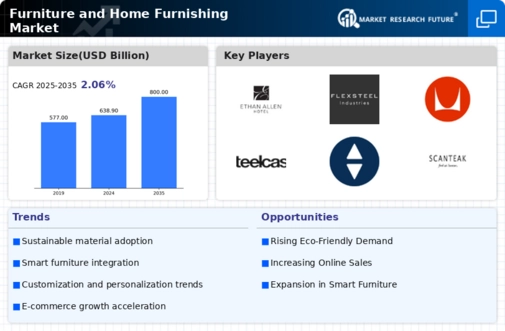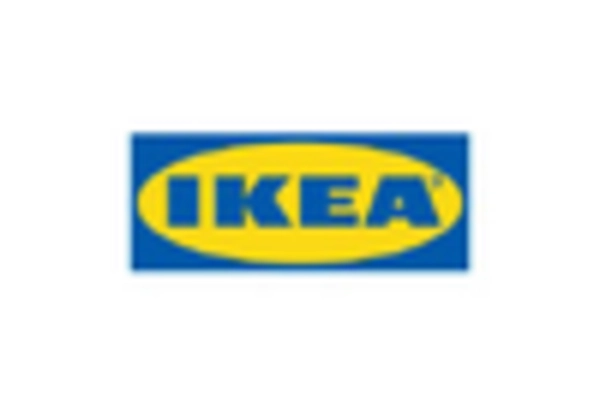Increased Focus on Sustainability
Sustainability has emerged as a pivotal driver in the Furniture and Home Furnishing Market, as consumers become more environmentally conscious. The demand for eco-friendly materials and sustainable production practices is on the rise, with a significant portion of consumers willing to pay a premium for sustainable products. Recent surveys indicate that over 70% of consumers consider sustainability when making purchasing decisions. This shift is prompting manufacturers to adopt greener practices, such as using reclaimed wood, non-toxic finishes, and recyclable materials. Furthermore, brands that prioritize sustainability are likely to enhance their reputation and attract a loyal customer base. As the market evolves, companies that fail to address sustainability may find themselves at a competitive disadvantage, as consumers increasingly favor brands that align with their values and contribute positively to the environment.
Expansion of Online Retail Channels
The Furniture and Home Furnishing Market is witnessing a significant transformation due to the expansion of online retail channels. E-commerce platforms are becoming increasingly popular among consumers, offering convenience and a wider selection of products. Recent statistics reveal that online furniture sales have grown by over 25% in the past year, indicating a shift in consumer purchasing behavior. This trend is further fueled by advancements in technology, such as augmented reality, which allows consumers to visualize how furniture will look in their homes before making a purchase. As a result, traditional brick-and-mortar retailers are compelled to enhance their online presence and invest in digital marketing strategies. Companies that successfully adapt to this shift are likely to capture a larger market share and meet the evolving expectations of tech-savvy consumers.
Rising Consumer Demand for Customization
The Furniture and Home Furnishing Market is experiencing a notable shift towards customization, as consumers increasingly seek personalized products that reflect their individual tastes and lifestyles. This trend is driven by a growing awareness of design options and the desire for unique home environments. According to recent data, approximately 60% of consumers express a preference for customized furniture solutions, indicating a significant market opportunity for manufacturers. Companies that offer bespoke services or modular designs are likely to gain a competitive edge, as they cater to this evolving consumer preference. Furthermore, the rise of online platforms facilitates the customization process, allowing consumers to visualize their choices in real-time. This trend not only enhances customer satisfaction but also fosters brand loyalty, as consumers feel a deeper connection to products that resonate with their personal identity.
Technological Advancements in Manufacturing
Technological innovations are reshaping the Furniture and Home Furnishing Market, leading to enhanced production efficiency and product quality. The integration of advanced manufacturing techniques, such as 3D printing and automation, allows companies to streamline operations and reduce costs. For instance, 3D printing technology enables the creation of complex designs that were previously unattainable, thus expanding the range of available products. Additionally, the use of smart technologies in manufacturing processes can lead to significant reductions in waste and energy consumption. Data suggests that manufacturers adopting these technologies can achieve up to a 30% increase in productivity. As a result, companies that invest in technological advancements are likely to improve their market position and meet the growing consumer demand for innovative and sustainable furniture solutions.
Growth of Urbanization and Smaller Living Spaces
The trend of urbanization is significantly influencing the Furniture and Home Furnishing Market, as more individuals and families move to urban areas where living spaces tend to be smaller. This demographic shift necessitates the development of space-saving furniture solutions that maximize functionality without compromising style. Data indicates that urban populations are expected to grow by over 50% in the next decade, creating a substantial demand for innovative furniture designs that cater to compact living. Manufacturers are responding by creating multi-functional furniture, such as sofa beds and modular storage units, which appeal to urban dwellers. This trend not only addresses the practical needs of consumers but also presents opportunities for designers to innovate and create aesthetically pleasing solutions that enhance the urban living experience.


















Leave a Comment